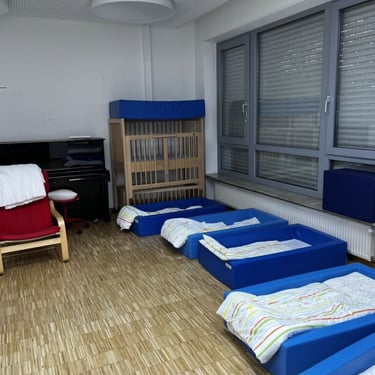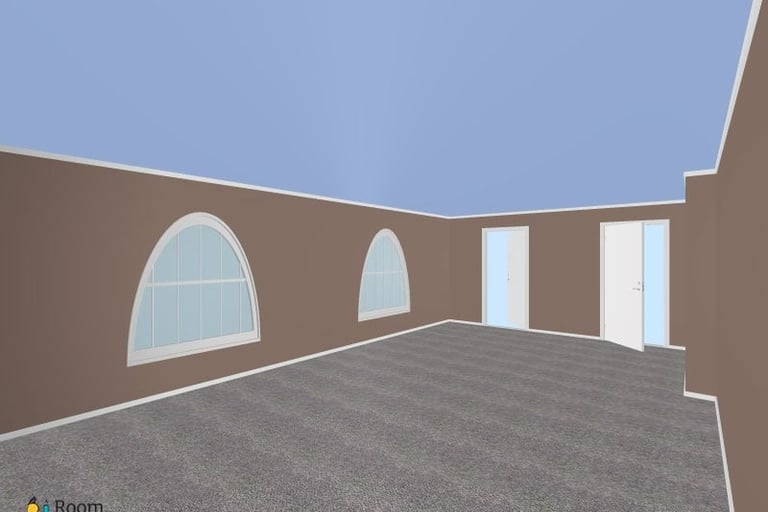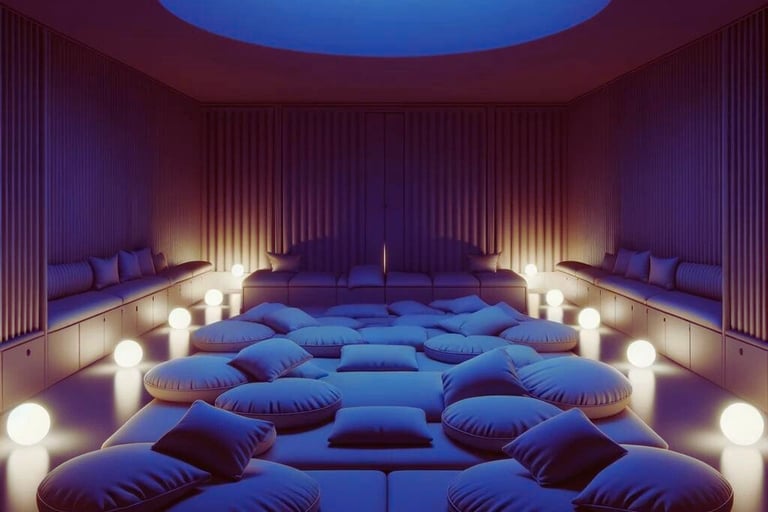Nursery room design: The active living space for children
Design your daycare center as a "third educator": Tips for an active, stimulating spatial concept that promotes well-being and self-directed learning processes.
MANAGEMENT(EN)


Historical Aspects of Room Design
To understand pedagogical room design in daycare centers, one must first, according to Wilk, take a historical look at the development of early childhood education as a whole. Over the centuries, many perspectives on the child have changed. Political and social changes have also had a formative influence on early childhood. The images of children as seen by educators have transformed. New pedagogical concepts emerged, and thus early childhood education became more complex and academic year after year.
In this context, it is important to note, with regard to room design, that the respective pedagogical concepts have individual requirements for the space. This is important to know because it clearly shows that a homogeneous room design applicable to all daycare centers cannot exist! Furthermore, it must not be forgotten that the pedagogical concept only represents a basic framework for the daycare center's operation. A concept only gains practical relevance through the specific pedagogical approach of each individual institution. These historical aspects should therefore always be kept in mind when designing the space. (cf. Wilk, pp. 17–54)
Stephanie Gebert has a similar perspective on the historical aspects. However, compared to Wilk, she offers a more in-depth view of the domestic children's room. From her perspective, neglecting this space leads to a significantly limited view of the developmental trajectory of early childhood. (cf. Rekus and Gebert 2021, pp. 21–30)
From my point of view, this is particularly understandable and correct, especially with regard to the past. Previously, childcare for children under three was hardly developed. Therefore, in earlier years, education and development took place at home for a longer period, which increased the influence of private spaces and the domestic children's room on child development.
Pedagogical Room Design
Room design, therefore, plays a significant role in early childhood development, both historically and currently. But what exactly does the term "space and pedagogical spatial design" mean, given that we constantly talk about spaces in our everyday lives? For us, a space is often a self-contained enclosure that can be measured from wall to wall and thus explained in purely mathematical and physical terms. (cf. Stieve and Schüllenbach-Bülow 2016, pp. 21–22)
In addition, there are the functions that we attribute to a space. In the kitchen, we cook and store food. The living room is where family and social life takes place. This also applies to spaces in daycare centers. However, we must also consider that different concepts have varying effects on the architecture and thus influence the spatial design. Similarly, there are interior spaces (daycare rooms) and exterior spaces (courtyard, garden) that are subject to spatial planning and design.
Designing Spaces
The basic design of rooms in daycare centers is guided, on the one hand, by the corresponding pedagogical concept. The interior design of the rooms also plays an important role. Depending on the room and its function, we must consider different requirements. Three fundamental design principles can be identified:
Creating orientation
Offering stimulation
Enabling well-being
These are explained in more detail using a practical example:
To promote well-being, suitable floor coverings can be used in different rooms. For example, carpet could be laid in the group room or sleeping area. In the movement room or the entrance area of a daycare center, a carpet would be counterproductive. Cooler and harder materials such as linoleum or rubber are more suitable here. The floor can also provide orientation as a guide. In inclusive facilities, a high-contrast guidance system is usually found in the center of the room.
The color of the floor covering also has a significant influence on well-being. It interacts with the walls and furnishings. The walls delineate the space and offer opportunities for orientation. They also provide children with ways to estimate height and distance. Walls can also be designed in different colors depending on the room.
This raises the question of what colors actually are and how they work. Color is ultimately nothing more than an object that reflects light at a specific wavelength. Some objects absorb more or certain wavelengths, and therefore only certain waves are reflected. This creates different colors, which are perceived differently by each person. Color impressions are always individual experiences. A deeper understanding of color choices is shown in diagram number 6 in the appendix.
In addition to the floor covering, the ceiling has a major influence on the acoustics of the room, and the word "noise" is particularly relevant here. Noise affects the learning, health, and well-being of the children and the staff. The average noise level in a daycare center is 60-70 decibels. These noise levels can generally be categorized into endogenous (children, staff, fans) and exogenous (street noise, dogs, airplanes) influencing factors. Appropriate acoustic measures can minimize noise pollution and thus make conversations easier to understand. The ceiling also serves as a support for lighting fixtures.
The specific features of the respective pedagogical concepts used must also be taken into account when furnishing the rooms. In Montessori daycare centers, the materials have fixed locations and should always be easily accessible to the children. In forest daycare centers, the focus of the space is on the natural environment. However, even there, there are often rooms such as construction trailers or huts. These are furnished in a nature-oriented way. The topic of room design and furnishings is most evident in the Reggio Emilia approach. Here, the rooms "function" as a third educator.
Research has increasingly focused on room design in daycare centers. Three types of spatial arrangement can be identified:
Open structure = the entire room is visible, play areas are not separated.
Visually restricted structure = furniture is used to divide areas.
Visually open structure = similar to the second type, but with a complete overview due to smaller furniture.
Research has shown that children in openly structured rooms are more active and engage in more movement-intensive activities. Children in visually open rooms, on the other hand, can orient themselves using room dividers and thus navigate and move around the daycare center more independently. A visually open structure should therefore be strived for, as it supports children in their choice of activities and promotes their autonomy.
This structuring can be achieved, for example, through the following measures:
Using room dividers only at a low height.
Positioning large cabinets accordingly along the edges of the room.
Upholstered elements can be used as a soft way of defining areas.
Using color depending on the play/activity area to create visual boundaries.
Floor markings are effective with children and can be used for demarcation. A play or activity area should accommodate between two and five children. A space of 5-10 square meters is recommended for this purpose. A general rule of thumb is that the children should be able to turn around with their arms outstretched while standing and stretch out fully while lying down. (cf. Bauer et al. 2016, pp. 33–62)
Daycare Quality and Space
In education, space serves as a supporting element in a pedagogical concept and the resulting design. However, this important insight is only partially considered in current planning. This is because the pedagogical director is usually only hired shortly before, and the pedagogical staff only at the start of operations. As a result, even the future head of the institution is not involved in the construction process, and thus the pedagogical concept develops with already established buildings, i.e., spaces. (cf. Wilk, pp. 95–97)
From my perspective, this leads to several problems. With already fixed spatial conditions, changes can only be implemented to a limited extent later on, and the staff's ability to influence the design is limited. This can lead to negative effects on daily pedagogical practice, for example, due to dissatisfaction or an unsuitable concept.
Furthermore, the spaces also influence the quality of the daycare center. Spaces affect the quality categories of orientation quality (e.g., space as a third educator/concept) and structural quality (material equipment of the rooms). Spaces also influence process quality. The more individually the space is adapted to the respective requirements, the better pedagogical professionals can communicate and interact with children, parents, etc.
Another important influence of spaces on daycare quality is the interaction between children and the spaces themselves. These spaces represent both a learning object and a learning environment for the children in the institution, which they can explore. This interaction (space <-> child) affects both the (self-)education of each child and the quality of interactions between children themselves, as well as between children and pedagogical professionals. (cf. Wilk, pp. 100–101)
Justification of the selected area
The sleeping room plays a significant role in the daycare center, especially for younger children. Resting and sleeping are a basic need in the daycare center, particularly for younger children. Factors such as a secure attachment and trust in the caregiver play an important role here. Likewise, the educational professionals should be able to proactively engage in contact-intensive interactions with the children. For some children, rest is often the priority. In these cases, the educators must offer additional relaxation activities that are suitable for the children. (cf. Kramer 2015, pp. 8–12)
Based on the daily routine, after the shared lunch, the children gather in their respective groups in the sleeping room from 11:30 a.m. onwards for their nap. However, it's not only the nursery children who nap there. Due to the concept of the Nikolauspflege institution and the inclusion practices in place, older children also use the sleeping room for naps. The sleeping room is also used and supervised by staff from different groups.
The transition from lunch to naptime is very important for the children themselves. Here, I would like to reiterate the particular challenges posed by the inclusion of children with physical and intellectual disabilities. In my view, these circumstances mean that high demands must be placed on the sleeping room in my practical placement setting, and these demands are currently not being met.
For this reason, the sleeping room was chosen as the space for the planned redesign and was analyzed and theoretically redesigned accordingly.
Initial Situation of the Selected Area
Now that I have described the importance of the sleeping room for the children, I would like to analyze the initial situation of the fictional sleeping room, which was created for this project, in the next step:
It should be noted that the sleeping area was not originally planned and furnished as such in the room concept. It was previously intended as a group room for a daycare group and equipped accordingly. After this daycare group moved to different rooms due to space limitations, this room was given a new function as a sleeping area, with all its advantages and disadvantages.
A major advantage of this room as a sleeping area is its easy accessibility. It is located on the same level as two other daycare groups and is situated towards the garden rather than the street. This results in a lower noise level in the sleeping area and better air quality.
Unfortunately, the room is poorly suited as a sleeping area due to its previous function and furnishings as a group room. There is a kitchenette with built-in appliances in the room. On the one hand, this distracts the children. On the other hand, the kitchenette creates a lot of unrest in the sleeping area and is useless. Furthermore, all the walls are painted white. On the one hand, the color white is understandable, because for visually impaired children, colors pose a particular challenge due to the reduced contrasts. On the other hand, as mentioned at the beginning of this analysis, color has a major influence on the room design and thus ultimately on the children's well-being. The needs of children without visual impairments must also be considered, and ultimately, when it comes to resting and sleeping, all children have similar needs, namely peace, security, and safety.
Another problem is the large windows. Although these can be darkened with roller blinds, these large openings still have a negative effect on a sleeping area. The ceiling is also white and fitted with large round lights, which are far too big and thus create an uncomfortable atmosphere. Unfortunately, these cannot be adjusted infinitely, so it is either too bright or too dark. Furthermore, the flooring must also be declared unsuitable. The patterns and colors appear restless and therefore activate the children more than they help them to calm down and fall asleep. The children have blue foam beds available for sleeping. The children like these beds very much. They are very soft and provide a feeling of security due to their enclosed design. Unfortunately, there are no other options for the children to rest. A piano has no place in a sleeping area and also serves as a distraction for the children. The sink is also a disruptive element in the sleeping area and therefore has a significant negative impact on its function as a place for sleep.
The current state of the room is consequently challenging. The room currently used as a sleeping area does not meet the basic needs of the children and thus contradicts the purpose of a sleeping area.
Suggestions for Improvement in the Selected Area
Following the theoretical introduction and the analysis of the sleeping area, meaningful conclusions can now be drawn for improving the functional space. The walls should be painted in a brown aubergine shade, which radiates security and tranquility. However, the use of a darker blue tone would also be conceivable. This color conveys trust and comfort to the children. However, since the children's beds are already dark blue, a similar wall color is, in my opinion, out of the question.
The many large round ceiling lights do not radiate calm and should be replaced by several star-shaped lamps on the wall or cloud-shaped lamps on the ceiling. These are also available with a color-coordinated border, which would be ideal for a sleeping area.
A combination of ceiling lights and a wall lamp as accent lighting would also be conceivable. This measure would make the room appear calmer and the light more diffused. Another positive aspect would be the change in Kelvin temperature. This would be reduced from the current approximately 4500 Kelvin to 2500-3000 Kelvin. This also promotes melatonin production in children, which in turn has a positive effect on sleep.
The kitchenette should be completely removed. It has no place in a sleeping area. The same applies to items such as the piano, the washing facilities, and unused children's beds. These freed-up areas could be used for variable resting options such as cozy corners, seating areas, and similar arrangements.
Children are different, and while younger children might want to lie down in the beds to sleep, older children might prefer to cuddle together on a seating area, or some might find the beds too cold. Therefore, a basket with a mattress and padding could be used. In short, the sleeping area as a functional space offers children the opportunity to have a say (participation). The sleeping area only needs a few pieces of furniture. A storage unit for cushions would be useful. This could be integrated into the space between the sleeping area and the group room. This would keep the sleeping area clear and quiet. A small shelf in the middle of the left wall would be useful for storing important documents and supplies. Furniture made of calm wood types, such as beech wood without carvings, would be suitable for this purpose.
Due to its cold properties and activating pattern, the floor should be covered with a carpet in a grayish beige color. This is because the children should have the opportunity to move around barefoot in the sleeping area. This promotes comfortable lying and cuddling in bed. It also allows the children's feet to experience softness and warmth, as a carpet provides warmth compared to a bare floor. The color is also grounding and calming and matches the wall color very well, thus preventing overstimulation of the visual senses and therefore avoiding activating the children.
Unfortunately, the large windows cannot be changed without major construction work. However, since this is a theoretical consideration with the goal of creating the best possible sleeping area for the children, these will also be modified. Large windows are usually advantageous in a group room, as the children have plenty of daylight and can perceive and observe their surroundings. However, they are unsuitable for a sleeping area. The large windows create a great deal of restlessness for sleeping. They do not convey a sense of security and comfort, and therefore a proper feeling of rest and sleep cannot be achieved. Therefore, the large window front should be replaced with two arched or round windows.



These should be coverable with a dark, star-patterned curtain. This measure will prevent the large window front from counteracting the overall effect of the room.
As an additional measure, the white radiators could be replaced with anthracite-gray radiators.
Designing Children's Sleeping Areas in the "Near" Future
Naturally, the question of how children's sleeping areas might be designed in the near future comes to the forefront. It seems essential to me to harmoniously combine traditional methods with modern insights. A sleeping area should not serve solely as a place to sleep. Rather, it should be designed in such a way that some children can quietly withdraw and rest without disturbing those who are already asleep. It would be desirable to create areas where several children can relax together. A daycare center should always consider the need for quiet, even for older children who may wish to retreat to a quiet corner with their best friend.
Let's now take a look at a visionary sleeping area of the future:


In the back of the room are the sleeping areas for those children who need to rest. A passageway to the right leads into a room designed as a quiet retreat where children can withdraw and relax. Both rooms are easily accessible from the left entrance area. From this vantage point, the caregiver has a clear view of both rooms and can thus ensure safe supervision.
This visionary quiet retreat could be designed as follows:


Children's Participation
Now that suggestions for improvement have been collected and documented, it's time to implement these measures. The children should, or rather must, be involved and be part of the "construction team." The redesign of the sleeping room could be carried out as a cross-group daycare project. The children could help with clearing out the room. During the renovation work, an alternative sleeping room must be provided, and the children can also have a say there.
After the structural renovations, such as changing the window front and removing the kitchenette and sink by specialist companies, the children can now be integrated into the further steps. They can help with cleaning and laying the carpet. The children can also help with painting the walls and installing curtains. Should the sleeping area be in the right or the left corner? This question, for example, could be clarified in a children's conference. This allows the children to experience that they too can represent and
implement their own interests. This also raises the question of whether the entire bedtime routine should be analyzed and revised together with the children. Perhaps the children would prefer to all go into the sleeping room together at once, instead of children coming in one after another. Because the frequent opening and closing of the door can further disturb the children's rest and sleep.
The entire children's project should definitely be documented photographically and visually together with the children. The specialist companies could also be integrated into this, allowing the children to get to know other professional groups. The children could also participate and help with mixing or spreading cement. Electricians could explain something about electricity to the children, and window installers about glass, and the educators could then pick up on these topics in further projects. In short, the daycare sleeping room project offers the children a wide range of opportunities for participation. The daycare center only has to seize these opportunities and ultimately accept and implement them.
Reflection on the task
At the beginning, I found this task very challenging and difficult. I had no prior experience with the spatial planning of daycare centers, so I was initially overwhelmed by a multitude of influences and ideas. In class, we discussed and analyzed many aspects of spatial design and planning. Visiting a practical setting then allowed me to connect this theoretical knowledge with real-world practice and discover new perspectives.
I chose the daycare center's sleeping room as my focus because some children were very reluctant to go to sleep there, and the room seemed completely unsuitable as a sleeping area. The room is used every day, and it doesn't meet the children's basic needs. Therefore, it was important for me to address this room and find possible solutions. The theoretical foundations of spatial planning in daycare centers confirmed my suspicions. It is therefore essential to consider how to improve the functionality of the sleeping room.
Planning and theoretically implementing a new room concept was a major challenge and brought me a great deal of joy. More and more ideas and design possibilities emerged, and in the end, I was surprised by the extensive ways in which a room can be positively or negatively altered for children. The significant influence of a well-designed sleeping room on children's development also surprised me.
This project made me realize how little attention is paid to the topics of spatial planning, room concepts, and interior design in the daily routine of daycare centers today. In my opinion, the children are also not sufficiently involved in these topics.
This project has sensitized me to these issues, and in the future, I will pay more attention to viewing daycare spaces as active living spaces for children and designing them together with the children.


